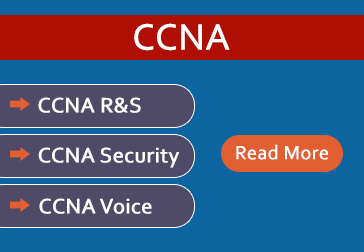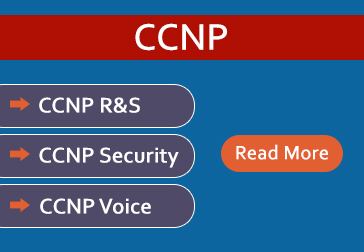All COURSES Offered
CCIE (Routing & Switching)
CCIE Certification:
Course Details
The CCIE is the crème-de-la-crème of Networking certifications, and there are less than 50,000 CCIEs worldwide across all specializations. To get into this exclusive club, you need to train with the very best people who have decades of expertise in teaching, implementing and managing enterprise class networking projects.

CCIE Certification:
CCIE Certification Introduction
The CCIE is the crème-de-la-crème of Networking certifications, and there are less than 50,000 CCIEs worldwide across all specializations. To get into this exclusive club, you need to train with the very best people who have decades of expertise in teaching, implementing and managing enterprise class networking projects.
The Networking industry is facing an acute shortage of qualified and trained CCIE Mapped professionals. IPST intends to fill this gap by providing the highest quality of CCIE Mapped training, with world class professionals and state of the art lab infrastructure.
The IPST Centre-of-Excellence for CCIE mapped certifications is the best fit to achieve this most coveted certification of the Networking world. The instructor led courses at the CCIE Mapped Centre-of-Excellence are taught under the guidance of CCIEs who have several years of real time experience in designing, implementing & managing large-scale networks like SWANs & Campus wide LANs, and not with mere academic knowledge got from books.
The instructors are highly experienced and certified CCIEs, who have been instrumental in setting up some of the largest networks in India .These Internetworking Experts have a thorough understanding of Cisco’s real time network design and implementation coupled with strong experience in conducting CCIE boot camps.
The course covers all the aspects of CCIE Routing and Switching Version 5. Labs are case study based, on state-of-the-art routers and switches meeting the requirements for CCIE certification.
IPST has a proven track record of over 15 years in training people for CCIE Mapped Certification.
IPST trains over 1000 engineers every month for CCNA/CCNP Mapped Certification which is a World Record.
CCIE Course Contents
CCIE Routing and Switching - Version 5.0 (400-101)
Exam Description: The Cisco CCIE® Routing and Switching Written Exam (400-101) version 5.0 is a 2- hour test with 90-110 questions that will validate that professionals have the expertise to: configure, validate, and troubleshoot complex enterprise network infrastructure; understand how infrastructure components interoperate; and translate functional requirements into specific device configurations. The exam is closed book and no outside reference materials are allowed.
The following topics are general guidelines for the content likely to be included on the exam. However, other related topics may also appear on any specific delivery of the exam.
1.0 Network Principles
2.0 Layer 2 Technologies
3.0 Layer 3 Technologies
4.0 VPN Technologies
5.0 Infrastructure Security
6.0 Infrastructure Services
1.0 Network Principles
1.1 Network theory
1.1.a Describe basic software architecture differences between IOS and IOS XE
1.1.a (i) Control plane and Forwarding plane
1.1.a (ii) Impact to troubleshooting and performances
1.1.a (iii) Excluding specific platform's architecture
1.1.b Identify Cisco express forwarding concepts
1.1.b (i) RIB, FIB, LFIB, Adjacency table
1.1.b (ii) Load balancing Hash
1.1.b (iii) Polarization concept and avoidance
1.1.c Explain general network challenges
1.1.c (i) Unicast flooding
1.1.c (ii) Out of order packets
1.1.c (iii) Asymmetric routing
1.1.c (iv) Impact of micro burst
1.1.d Explain IP operations
1.1.d (i) ICMP unreachable, redirect
1.1.d (ii) IPv4 options, IPv6 extension headers
1.1.d (iii) IPv4 and IPv6 fragmentation
1.1.d (iv) TTL &1.1.d (v) IP MTU
1.1.e Explain TCP operations
1.1.e (i) IPv4 and IPv6 PMTU
1.1.e (ii) MSS &1.1.e (iii) Latency &1.1.e (iv) Windowing
1.1.e (v) Bandwidth delay product
1.1.e (vi) Global synchronization &1.1.e (vii) Options
1.1.f Explain UDP operations
1.1.f (i) Starvation &1.1.f (ii) Latency
1.1.f (iii) RTP/RTCP concepts
1.2 Network implementation and operation
1.2.a Evaluate proposed changes to a network
1.2.a (i) Changes to routing protocol parameters
1.2.a (ii) Migrate parts of a network to IPv6
1.2.a (iii) Routing protocol migration
1.2.a (iv) Adding multicast support
1.2.a (v) Migrate spanning tree protocol
1.2.a (vi) Evaluate impact of new traffic on existing QoS design
1.3 Network troubleshooting
1.3.a Use IOS troubleshooting tools
1.3.a (i) debug, conditional debug
1.3.a (ii) ping, traceroute with extended options
1.3.a (iii) Embedded packet capture
1.3.a (iv) Performance monitor
1.3.b Apply troubleshooting methodologies
1.3.b (i) Diagnose the root cause of networking issue (analyze symptoms,
identify and describe root cause)
1.3.b (ii) Design and implement valid solutions according to constraints
1.3.b (iii) Verify and monitor resolution
1.3.c Interpret packet capture
1.3.c (i) Using Wireshark trace analyzer
1.3.c (ii) Using IOS embedded packet capture
2.0 Layer 2 Technologies
2.1 LAN switching technologies
2.1.a Implement and troubleshoot switch administration
2.1.a (i) Managing MAC address table
2.1.a (ii) errdisable recovery
2.1.a (iii) L2 MTU
2.1.b Implement and troubleshoot layer 2 protocols
2.1.b (i) CDP, LLDP
2.1.b (ii) UDLD
2.1.c (i) Access ports
2.1.c (ii) VLAN database
2.1.c (iii) Normal, extended VLAN, voice VLAN
2.1.d (i) VTPv1, VTPv2, VTPv3, VTP pruning
2.1.d (ii) dot1Q
2.1.d (iii) Native VLAN
2.1.d (iv) Manual pruning
2.1.e (i) LACP, PAgP, manual
2.1.e (ii) Layer 2, layer 3
2.1.e (iii) Load-balancing
2.1.e (iv) Etherchannel misconfiguration guard
2.1.f (i) PVST+/RPVST+/MST
2.1.f (ii) Switch priority, port priority, path cost, STP timers
2.1.f (iii) port fast, BPDUguard, BPDUfilter
2.1.f (iv) loopguard, rootguard
2.1.g (i) SPAN, RSPAN, ERSPAN
2.1.h (i) Multichassis
2.1.h (ii) VSS concepts
2.1.h (iii) Alternative to STP
2.1.h (iv) Stackwise
2.1.h (v) Excluding specific platform implementation
2.1.i (i) Compatibility between MST and RSTP
2.1.i (ii) STP dispute, STP bridge assurance
2.2.a Implement and troubleshoot IGMP
2.2.a (i) IGMPv1, IGMPv2, IGMPv3
2.2.a (ii) IGMP snooping
2.2.a (iii) IGMP querier
2.2.a (iv) IGMP filter
2.2.a (v) IGMP proxy
2.2.c Explain PIM snooping
2.3 Layer 2 WAN circuit technologies
2.3.a Implement and troubleshoot HDLC
2.3.b Implement and troubleshoot PPP
2.3.b (i) Authentication (PAP, CHAP)
2.3.b (ii) PPPoE
2.3.b (iii) MLPPP
2.3.c (i) Metro and WAN Ethernet topologies
2.3.c (ii) Use of rate-limited WAN ethernet services
3.0 Layer 3 Technologies
3.1 Addressing technologies
3.1.a Identify, implement and troubleshoot IPv4 addressing and subnetting
3.1.a (i) Address types, VLSM
3.1.a (ii) ARP
3.1.b (i) Unicast, multicast
3.1.b (ii) EUI-64
3.1.b (iii) ND, RS/RA
3.1.b (iv) Autoconfig/SLAAC, temporary addresses (RFC4941)
3.1.b (v) Global prefix configuration feature
3.1.b (vi) DHCP protocol operations
3.1.b (vii) SLAAC/DHCPv6 interaction
3.1.b (viii) Stateful, stateless DHCPv6
3.1.b (ix) DHCPv6 prefix delegation
3.2 Layer 3 multicast
3.2.a Troubleshoot reverse path forwarding
3.2.a (i) RPF failure
3.2.a (ii) RPF failure with tunnel interface
3.2.b (i) PIM dense mode, sparse mode, sparse-dense mode
3.2.b (ii) Static RP, auto-RP, BSR
3.2.b (iii) BiDirectional PIM
3.2.b (iv) Source-specific multicast
3.2.b (v) Group to RP mapping
3.2.b (vi) Multicast boundary
3.2.c (i) Intra-domain MSDP (anycast RP)
3.2.c (ii) SA filter
3.2.d (i) IPv6 multicast addresses
3.2.d (ii) PIMv6
3.3 Fundamental routing concepts
3.3.a Implement and troubleshoot static routing
3.3.b Implement and troubleshoot default routing
3.3.c Compare routing protocol types
3.3.c (i) Distance vector
3.3.c (ii) Link state
3.3.c (iii) Path vector
3.3.e Implement and troubleshoot passive interface
3.3.f Implement and troubleshoot VRF lite
3.3.g Implement, optimize and troubleshoot filtering with any routing protocol
3.3.h Implement, optimize & troubleshoot redistribution between any routing protocol
3.3.i Implement, optimize & troubleshoot manual & auto summarization with any routing protocol
3.3.j Implement, optimize and troubleshoot policy-based routing
3.3.k Identify and troubleshoot sub-optimal routing
3.3.l Implement and troubleshoot bidirectional forwarding detection
3.3.m Implement and troubleshoot loop prevention mechanisms
3.3.m (i) Route tagging, filtering
3.3.m (ii) Split horizon
3.3.m (iii) Route poisoning
3.3.n (i) MD5
3.3.n (ii) Key-chain
3.3.n (iii) EIGRP HMAC SHA2-256bit
3.3.n (iv) OSPFv2 SHA1-196bit
3.4 RIP (v2 and v6)
3.4.a Implement and troubleshoot RIPv2
3.4.b Describe RIPv6 (RIPng)
3.5 EIGRP (for IPv4 and IPv6)
3.5.a Describe packet types
3.5.a (i) Packet types (hello, query, update, and such)
3.5.a (ii) Route types (internal, external)
3.5.b (i) Multicast, unicast EIGRP peering
3.5.b (ii) OTP point-to-point peering
3.5.b (iii) OTP route-reflector peering
3.5.b (iv) OTP multiple service providers scenario
3.5.c (i) RD, FD, FC, successor, feasible successor
3.5.c (ii) Classic metric
3.5.c (iii) Wide metric
3.5.d (i) General operations
3.5.d (ii) Topology table, update, query, active, passive
3.5.d (iii) Stuck in active
3.5.d (iv) Graceful shutdown
3.5.e (i) Stub
3.5.e (ii) Leak-map
3.5.f (i) equal-cost
3.5.f (ii) unequal-cost
3.5.f (iii) add-path
3.5.g (i) Types of families
3.5.g (ii) IPv4 address-family
3.5.g (iii) IPv6 address-family
3.5.h Implement, troubleshoot and optimize EIGRP convergence and scalability
3.5.h (i) Describe fast convergence requirements
3.5.h (ii) Control query boundaries
3.5.h (iii) IP FRR/fast reroute (single hop)
3.5.8 (iv) Summary leak-map
3.5.h (v) Summary metric
3.6 OSPF (v2 and v3)
3.6.a Describe packet types
3.6.a (i) LSA types (1, 2, 3, 4, 5, 7, 9)
3.6.a (ii) Route types (N1, N2, E1, E2)
3.6.c Implement and troubleshoot OSPFv3 address-family support
3.6.c (i) IPv4 address-family
3.6.c (ii) IPv6 address-family
3.6.d (i) Point-to-point, multipoint, broadcast, non-broadcast
3.6.d (ii) LSA types, area type: backbone, normal, transit, stub, NSSA, totally stub
3.6.d (iii) Internal router, ABR, ASBR
3.6.d (iv) Virtual link
3.6.f Implement and troubleshoot operations
3.6.f (i) General operations
3.6.f (ii) Graceful shutdown
3.6.f (iii) GTSM (Generic TTL Security Mechanism)
3.6.g (i) Metrics
3.6.g (ii) LSA throttling, SPF tuning, fast hello
3.6.g (iii) LSA propagation control (area types, ISPF)
3.6.g (iv) IP FRR/fast reroute (single hop)
3.6.g (v) LFA/loop-free alternative (multi hop)
3.6.g (vi) OSPFv3 prefix suppression
3.7 BGP
3.7.a Describe, implement and troubleshoot peer relationships
3.7.a (i) Peer-group, template
3.7.a (ii) Active, passive
3.7.a (iii) States, timers
3.7.a (iv) Dynamic neighbors
3.7.b (i) EBGP, IBGP
3.7.b (ii) 4 bytes AS number
3.7.b (iii) Private AS
3.7.d Implement, optimize and troubleshoot routing policies
3.7.d (i) Attribute manipulation
3.7.d (ii) Conditional advertisement
3.7.d (iii) Outbound route filtering
3.7.d (iv) Communities, extended communities
3.7.d (v) Multi-homing
3.7.e (i) Route-reflector, cluster
3.7.e (ii) Confederations
3.7.e (iii) Aggregation, AS set
3.7.f (i) IPv4, IPv6, VPN address-family
3.7.g Implement and troubleshoot AS path manipulations
3.7.g (i) Local AS, allow AS in, remove private AS
3.7.g (ii) Prepend
3.7.g (iii) Regexp
3.7.h (i) Multipath
3.7.h (ii) BGP synchronization
3.7.h (iii) Soft reconfiguration, route refresh
3.7.i (i) Prefix independent convergence
3.7.i (ii) Add-path
3.7.i (iii) Next-hop address tracking
3.8.a Describe basic ISIS network
3.8.a (i) Single area, single topology
3.8.b Describe neighbor relationship
3.8.c Describe network types, levels and router types
3.8.c (i) NSAP addressing
3.8.c (ii) Point-to-point, broadcast
3.8.d Describe operations
3.8.e Describe optimization features
3.8.e (i) Metrics, wide metric
4.0 VPN Technologies
4.1 Tunneling
4.1.a Implement and troubleshoot MPLS operations
4.1.a (i) Label stack, LSR, LSP
4.1.a (ii) LDP
4.1.a (iii) MPLS ping, MPLS traceroute
4.1.b Implement and troubleshoot basic MPLS L3VPN
4.1.b (i) L3VPN, CE, PE, P
4.1.b (ii) Extranet (route leaking)
4.1.c (i) GRE
4.1.c (ii) Dynamic GRE
4.1.c (iii) LISP encapsulation principles supporting EIGRP OTP
4.1.d (i) NHRP
4.1.d (ii) DMVPN with IPsec using preshared key
4.1.d (iii) QoS profile
4.1.d (iv) Pre-classify
4.1.e (i) 6in4, 6to4
4.1.e (ii) ISATAP
4.1.e (iii) 6RD
4.1.e (iv) 6PE/6VPE
4.1.g (i) L2TPv3 general principals
4.1.g (ii) ATOM general principals
4.1.h (i) MPLS-VPLS general principals
4.1.h (ii) OTV general principals
4.2.a Implement and troubleshoot IPsec with preshared key
4.2.a (i) IPv4 site to IPv4 site
4.2.a (ii) IPv6 in IPv4 tunnels
4.2.a (iii) Virtual tunneling Interface (VTI)
5.0 Infrastructure Security
5.1 Device security
5.1.a Implement and troubleshoot IOS AAA using local database
5.1.b Implement and troubleshoot device access control
5.1.b (i) Lines (VTY, AUX, console)
5.1.b (ii) SNMP
5.1.b (iii) Management plane protection
5.1.b (iv) Password encryption
5.1.c Implement and troubleshoot control plane policing
5.1.d Describe device security using IOS AAA with TACACS+ and RADIUS
5.1.d (i) AAA with TACACS+ and RADIUS
5.1.d (ii) Local privilege authorization fallback
5.2.a Implement and troubleshoot switch security features
5.2.a (i) VACL, PACL
5.2.a (ii) Stormcontrol
5.2.a (iii) DHCP snooping
5.2.a (iv) IP source-guard
5.2.a (v) Dynamic ARP inspection
5.2.a (vi) port-security
5.2.a (vii) Private VLAN
5.2.b Implement and troubleshoot router security features
5.2.b (i) IPv4 access control lists (standard, extended, time-based)
5.2.b (ii) IPv6 traffic filter
5.2.b (iii) Unicast reverse path forwarding
5.2.c Implement and troubleshoot IPv6 first hop security
5.2.c (i) RA guard
5.2.c (ii) DHCP guard
5.2.c (iii) Binding table
5.2.c (iv) Device tracking
5.2.c (v) ND inspection/snooping
5.2.c (vii) Source guard
5.2.c (viii) PACL
5.2.d Describe 802.1x
5.2.d (i) 802.1x, EAP, RADIUS
5.2.d (ii) MAC authentication bypass
6.0 Infrastructure Services
6.1 System management
6.1.a Implement and troubleshoot device management
6.1.a (i) Console and VTY
6.1.a (ii) telnet, HTTP, HTTPS, SSH, SCP
6.1.a (iii) (T)FTP
6.1.b Implement and troubleshoot SNMP
6.1.b (i) v2c, v3
6.1.c Implement and troubleshoot logging
6.1.c (i) Local logging, syslog, debug, conditional debug
6.1.c (ii) Timestamp
6.2.a Implement and troubleshoot end-to-end QoS
6.2.a (i) CoS and DSCP mapping
6.2.b Implement, optimize and troubleshoot QoS using MQC
6.2.b (i) Classification
6.2.b (ii) Network based application recognition (NBAR)
6.2.b (iii) Marking using IP precedence, DSCP, CoS, ECN
6.2.b (iv) Policing, shaping
6.2.b (v) Congestion management (queuing)
6.2.b (vi) HQoS, sub-rate ethernet link
6.2.b (vii) Congestion avoidance (WRED)
6.2.c Describe layer 2 QoS
6.2.c (i) Queuing, scheduling
6.2.c (ii) Classification, marking
6.3.a Implement and troubleshoot first-hop redundancy protocols
6.3.a (i) HSRP, GLBP, VRRP
6.3.a (ii) Redundancy using IPv6 RS/RA
6.3.b Implement and troubleshoot network time protocol
6.3.b (i) NTP master, client, version 3, version 4
6.3.b (ii) NTP Authentication
6.3.c Implement and troubleshoot IPv4 and IPv6 DHCP
6.3.c (i) DHCP client, IOS DHCP server, DHCP relay
6.3.c (ii) DHCP options
6.3.c (iii) DHCP protocol operations
6.3.c (iv) SLAAC/DHCPv6 interaction
6.3.c (v) Stateful, stateless DHCPv6
6.3.c (vi) DHCPv6 prefix delegation
6.3.d Implement and troubleshoot IPv4 network address translation
6.3.d (i) Static NAT, dynamic NAT, policy-based NAT, PAT
6.3.d (ii) NAT ALG
6.3.e Describe IPv6 network address translation
6.3.e (i) NAT64
6.3.e (ii) NPTv6
6.4.a Implement and troubleshoot IP SLA
6.4.a (i) ICMP, UDP, Jitter, VoIP
6.4.b (i) Tracking object, tracking list
6.4.b (ii) Tracking different entities (e.g. interfaces, routes, IPSLA, and such)
6.4.c (i) Netflow v5, v9
6.4.c (ii) Local retrieval
6.4.c (iii) Export (configuration only)
6.4.d (i) EEM policy using applet
6.4.e (i) Basic load balancing
6.4.e (ii) Voice optimization
Course Duration: 6 Month
Course Schedule
| Month | Batch | Starting Date | Time |
| January March May July September November |
Morning | 15th | 8.30 a.m. to 11.30 a.m. |
| February April June August October December |
Evening | 15th | 5.00p.m. to 8.00 p.m. |
Practical's/labs for Morning batch can be done 2 hour after the theory session
Practical's/labs for Evening batch can be done 2 hour before the theory session
If 15th is a Sunday or National holiday then the course will start on next workingday.
Course Fees
The Classroom CCIE training program at IP Solutions Technologies is priced at
Fee: INR 1,00,000* /- Pay Now
* All prices subject to a 14% Service Tax Charge. Rates are quoted in U.S. dollars, Britain Pounds and Nigerian Nairas are subject to change according to Foreign Exchange rates.
* For online Credit/Debit Card payment, surcharge 5% is charged to the Course fee.
Fee Payment Options:
1. Pay via Debit / Credit Card:
2. Pay Via Paypal:
(Paypal option will work only for payments made from outside India. PayPal cannot be used for domestic payments within India.)








